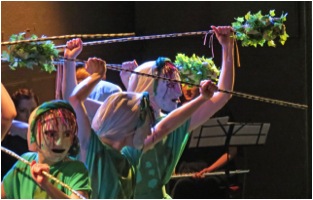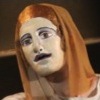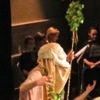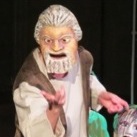Bacchae
Adapted and directed by Chris Vervain
5 - 11 March 2015
Theatro Technis
26 Camden Road, London
Review by Julie Ackroyd
Open University
The director of Bacchae is Chris Vervain, an artist and theatre practitioner who specialises in productions which utilise masked performance. Her work is informed by research initially undertaken whilst she was working on her PhD (completed in 2008) at Holloway College, part of the University of London in the UK. Her previous fully staged, masked presentations have included Sophocles’ Antigone in 2011, Aeschylus’ Libation Bearers in 2012 and Euripides’ The Women of Troy in 2014.
Vervain’s skill lies in serving as a very confident facilitator among musicians, choreographer, actors and audience. Presenting a performance in mask, with fully integrated and meaningful movement, is a daunting challenge for many modern actors unless they have attended a specialised theatre school with training in physical theatre and mask work. In most theatre training, mask work is an ancillary skill for a niche market which the majority of actors will never be called on to use. As a result, bringing a full cast up to speed in the technique and ensuring that the chorus works as a co-ordinated whole is often beyond many companies’ abilities. The cast of Vervain’s Bacchae is an exception that has created a compelling and eminently watchable performance. In order to present Bacchae, Vervain deliberately issued an open casting call for young, professionally trained actors of similar physical build and athleticism. When asked about the importance of casting, she has said that ‘the right kind of performer’ is essential in order to make the most accessible kind of production. ‘In build they can’t be too well filled out or we find ourselves in the world of comedy’. On the other hand, ‘variation in height does not matter in the chorus and is rather pleasing and useful – the shorter people can stand towards the front – so we are less in danger of losing some of the choral masked faces’. However, ‘for the main roles it is a different matter; certain roles demand height, e.g. a short Dionysus towered over by a tall Pentheus would be incongruous and would take the audience’s attention away from the important themes of the action.’ Here it is paramount to avoid straining the belief of the audience. The mask demands a lot of initial concentration from an audience, who are generally unfamiliar with the presentational tropes which it involves. The rest of the experience must be made as accessible as possible. In using mask Vervain believes that ‘the audience can experience a very different art form than they are used to, stimulating them on many different levels at once. There is nothing quite like the magic of mask in this context and you have to be there in person to really appreciate it!’
The fact that the full production was in rehearsal for only three and a half weeks before the performance opened in front of a paying audience is staggering. Its success in drilling fourteen people who have never worked together as a masked ensemble into a team functioning at such a high standard is a great compliment to the working methods of the director and the rest of the creative crew. By comparison, Peter Hall’s version of Tony Harrison’s Oresteia at the National Theatre in London had four months of rehearsal whilst the Oedipus plays had ten weeks… (1981 and 1996 respectively). In selecting her actors Vervain has deliberately cast ‘talented people’ with ‘little or no previous mask experience, but their expertise in theatrical communication, both naturalistic and stylised, means that in rehearsal they quickly see how mask performance technically works’. She adds that it is essential to choose actors who have ‘intelligence and the ability to learn quickly!’ Vervain actually avoids working with those who have specialised in mask training, since they ‘tend to come with preconceptions on how mask should be approached and employed which may impede the homogenous development of the company. Moreover mask work in the West today often focuses on improvisation and comedy and there is the idea around that mask and the complex text are not compatible, also that it is half masks that speak whilst masks that cover the whole face are silent. This is of course nonsense when you consider the practice of the ancient theatre. For Greek tragedy I have found my own way of employing mask, using some of the insights of masking coming out of the schools following the work of Copeau, but discarding others.’
Vervain constructs the full-face masks she uses, modelling them on images from vase and archaeological sources. They in no way impede the delivery of the lines, which are enunciated clearly by a cast who obviously have a strong textual training. Even when the chorus are delivering the lines in unison the meaning is never lost or subsumed by the accompanying music, a beautifully sparse composition by Penelope Anne Shipley. In most of the play it takes the form of three voices creating a strange and exotic harmony which splits and then re-joins to give a dissonant and eerie texture to the proceedings. Shipley is joined in the singing by Anita Creed and Katie Arnstein, who all balance each other out and give a very pleasing turn to the score. An occasional instrumental underscoring of the singing, provided by flute, tambourine and drum, adds sharpness and imposes an inescapable beat on the music when it is needed to keep the chorus together during crucial parts of the dialogue, as well as punctuating such scenes as the collapse of Pentheus’ palace. The whole soundscape is highly effective. Vervain and Shipley have worked together before, and the availability of a musical director throughout the whole rehearsal period has resulted in a fully integrated score. Vervain adds that their close collaboration made it possible to introduce suitable ‘musical themes as we went along [through the rehearsal process], adjusting them and writing new material as necessary.’ Shipley also helped guide the daily work of the cast by taking on the additional role of Assistant Director. In this capacity she led the ‘daily vocal and physical warm ups’ which are essential for putting the cast in the right frame of mind for work. Her active knowledge of the strengths of the cast and chorus seems to have informed the score.
The choreography, by Jemma Gould, is well calibrated to the emotions raised by the music. Her movement pattern is initially based on strong diagonals. The chorus create undulating chains of movement across the performance space, then settle into tableaus where the sameness of the masks is offset by the differences in their resting posture. The simple tilt of a head combined with a still body indicates that each Bacchant is listening attentively as the speaker from the chorus relates the narrative. The size of the performance space makes the movements of the chorus work best when there are no more than seven onstage. Early in the play twelve chorus members are present, creating a slight feeling of visual congestion as they dance. There were a couple of small collisions between masked Bacchants, a side effect of very complex patterns which relied on the perfect placement of each individual. (I was assured that these mishaps only occurred on the night I attended.) Such errors are forgivable; anyone who has experimented with mask work will agree that the difficulties of choreographed movement are magnified by limited vision and restricted space. According to Vervain, the visual problems are also ‘exacerbated many times over once stage lighting comes into play’. Obviously a performance in daylight in a larger outdoor orchêstra would help to iron out these difficulties and the choreography would definitely transfer to that kind of space with no loss of meaning. The initial brief from director to choreographer was to have an ‘energetic’ Choral Entry Dance, an intention wholly fulfilled by the entry of the full chorus of twelve carrying thyrsi. (Two separate chorus members who took possession of the rear skênê later delivered the choral dialogue.) In rehearsal the creative team’s approach to integrating the music and dance ‘followed a sort of an iterative path, from movement to text to dance to mask to speaking and dancing in mask. Thus Jemma [Gould] started by introducing typical poses and moves indicated by the ancient images – a sort of movement vocabulary underpinning much of her specific choreography. We used this introduction as a group bonding exercise for the whole cast, including our two male actors who weren’t in the chorus. They both subsequently found this vocabulary useful in that it informed some of their own movement choices.’
Vervain brings up the point that ‘Mask highlights the physical aspects of the performance’, necessitating the integration of a suitable movement vocabulary into the production. The form ‘requires performers to move with the grace and awareness of “natural dancers”; that is, they must carry within them an innate understanding of the language of bodily expression – which, incidentally, is the starting point for what we call “physical theatre”. They also need extraordinary stamina – performing in mask is exhausting!’ I can vouch for mask’s demands on the performer, having participated in some of Vervain’s masked workshops in the past. Without peripheral vision, the constant need to gauge distance and to be aware of the movement of other cast members is tiring, as is the heat within the masks. These challenging conditions demand actors who have a generosity of spirit and can ‘accept direction’ as well ‘as work well in ensemble’. Vervain fosters this ensemble feeling by ensuring that ‘the cast is present every working day, either “on stage” or otherwise participating by observing and helping each other realise their roles. It is very much a group activity with many of the cast doubling, performing the minor roles or attendants as well as being in the chorus and playing or understudying the main parts.’ This is the first time that Vervain and Gould have worked together, and the partnership has been successful. Gould, a professional dancer and choreographer, has independently studied the movement and poses depicted in Greek images of dance and combat. She has accomplished the sometimes-conflicting tasks of drilling the chorus in their moves and performing as one of them.
The selection of appropriate performance text and the difficulties the choice can cause in performance is a major consideration when planning a production. Vervain has chosen the version of the play by Philip Vellacott (second edition, 1973), ‘a translation that stays as close as possible to the to the original Greek—speech by speech, image by image, in as much as we can actually recover it—but that also conveys a sense of the poetic nature of the drama.’ As Vervain also points out, ‘many performable translations are clearly made with the unmasked theatre in mind’, and a text has to be selected carefully, for ‘there are a lot of turgid scholarly ones around’ which do not lend themselves to a satisfying dramatic experience for the audience or give a structure performable by an actor. If the right script is used, ‘Mask actually helps bring such a text to life and enables a variety of performance styles to be practiced.’ The mask frees the performer from ‘the overtly literal interpretation of the theatre of Naturalism. Mask lends itself to a more universal portrayal whilst still conveying the pathos of the tragic theme’.
The Bacchae’s central conflict between Pentheus and Dionysus is triggered when the god arrives in Thebes to tell the House of Cadmus that the gods must be reverently honoured. Will Bryant, as the doomed Pentheus, conveys an initial arrogance as he clicks his fingers to attendants and visitors alike in order to get the reactions and actions he desires. Early in the play he is too preoccupied by his own agenda to notice that the chorus are stalking him in a very predatory manner, focusing on his movements with intensity. This is a strong visual foreshadowing for those familiar with the story, who know that he will later be torn limb from limb on the slopes of Mount Cithaeron. A subtlety in Bryant’s portrayal which would be lost in a larger acting space is his use of breath to punctuate his dialogue. His Pentheus hyperventilates during moments of decision and stress, an effect made audible by his mask. When Pentheus is faced with Dionysus, played by Alexander Pett, both use poses and body language as weapons in a duel over status. Dionysus appears ungodlike only when he is arrested and slides into a parody of his previously controlling character by allowing himself to be shepherded by a guard with a self-important, swaggering walk. This comedic guard, Rowan Winter, is soon ushered off by Pentheus, who wishes to interrogate Dionysus himself. Dionysus the god reasserts himself when alone with Pentheus and, with the help of a change in the lighting to a seductive red, easily persuades Pentheus to dress as a Bacchant and see the women’s rites on the mountain. The costumes, designed by Chris Vervain and made by Linda Kerr and Freida Bier, are unisex belted or fitted tunics for the chorus and main characters. As a consequence, Pentheus’ change from male ruler’s garb to a Bacchant’s costume is more a matter of colour and drape than a strong shift of sex identity; his bewitched and dreamlike state is conveyed mostly by body language. Thus a potentially difficult moment for a modern audience—when Pentheus arrives in women’s garb—is less about awkward cross dressing than about his motivations. It also indicates that his new manner, while provoked by Dionysus, was already latent in Pentheus’ personality. As he assumes the poses of his female relatives (now Bacchants), his feminised body language does raise a laugh from the audience, making him appear out of control and rather ridiculous in contrast with his earlier imperious bearing. This lightness of touch is continued by Alyssa Burnett as the Messenger who delivers the chilling news of Pentheus’ death. She describes his dismemberment without sensationalism, but with a thoughtful and measured delivery that allows the audience to absorb the narrative leading up to the harrowing climax.
Other cast members also deserve a mention. Joanna Howden as Tiresias uses body language to convey the seer’s age, humanizing her character with the small touches of clawed hands, gnarled toes, and a wandering, tottering walk that indicate an old body riddled with arthritis. The proud old man is never cowed, even when Pentheus tries to browbeat him. Also noteworthy is the final appearance of Dionysus, when Alexander Pett, who has portrayed the character throughout the performance, is joined by Will Bryant and Alyssa Burnett to create a trinity—a frightening, black-garbed, three-headed, six-armed Dionysus who is featureless and wreathed in ivy. This god is implacable as he names the current and future punishment for members of the House of Cadmus. In this pronouncement there is no room for sympathy for the family, or any tinge of satisfaction with the rites the women of the city have selflessly performed for him.
The whole performance was well judged, audible and peppered with nuances which made the evening eminently watchable both for those familiar with classical masked Greek plays and for those new to the genre. The changes in pace and delivery by the actors and chorus went well with the musical score and movement. I look forward to seeing future productions from this creative team, who have made a difficult medium accessible, understandable and relevant to a modern audience.
bibliography
Chris Vervain mask-making website, http://home.btconnect.com/chrisvervain.org.uk (Accessed 22/04/2015).
Christine M. Lambert [Chris Vervain], "Performing Greek tragedy in mask; re-inventing a lost tradition", diss. Royal Holloway, London, 2008.
National Theatre, London, Peter Hall, director: Oresteia, 1981.
National Theatre, London, Peter Hall, director: Oedipus plays, 1996.
National Theatre Greek Plays and Performance site. http://www.nationaltheatre.org.uk/backstage/greek-theatre (Accessed 22/04/2015).
Philip Vellacot Bacchae translation in The Bacchae and Other Plays, 2nd ed., Penguin Books, 1973.




